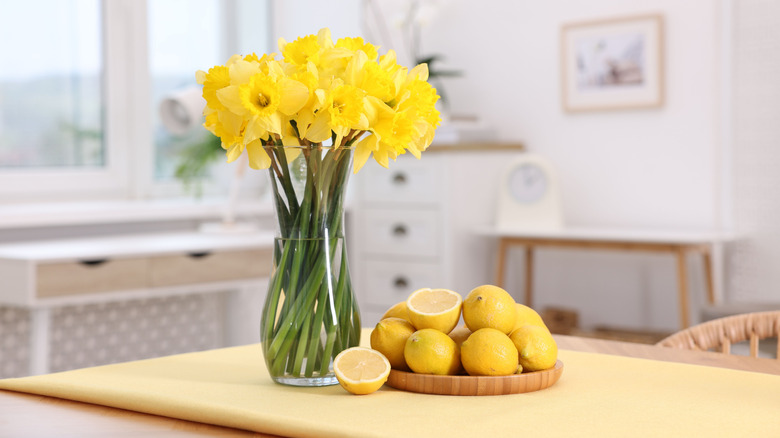Lemon Flower Arrangements Are Trending, But Are There Any Benefits?
The taste of unfiltered lemons may make your lips pucker up, but the scent of these citrus fruits makes your nose and your soul happy. They're also just stunningly beautiful. It's no wonder that so many home decorators display them in everything from bowls to vases to create flower arrangements that don't play by the rules. One of the most recent trends embraces putting whole lemons in a wide vase, immersing them in water, and topping the display with an explosion of yellow blooms and baby's breath.
You might wonder if those plump lemons on the bottom of the vessel serve any function, aside from looking ever so nice. If you've ever made a simple centerpiece arrangement by putting a dozen lemons in a bowl, it's likely that your lemons dried out in about a week. But some savvy home gourmands like TikToker Angus Wan submerge whole lemons in water and put them in the fridge to keep them fresher longer — up to a month by some accounts. It stands to reason, then, that putting lemons in the water of your flower arrangements could serve a similar function — preventing the fruits from drying out prematurely and ruining the arrangement in the process. Of course, it's important to note that cold water can shock root systems, so this might not be ideal.
If left long enough, whole lemons in the bottom of your floral arrangement might also ferment (bubble are a sign of this process). This can add a lemony scent to the room, though the bacteria produced by fermentation might not be ideal for flower growth. At the end of the day, asking about the benefits of lemons in your flower arrangement might not actually be the right question. After all, anyone who's into decorating with fruits, including lemons, is likely focused on aesthetics. With that said, there are ways to get benefits out of lemons and lemon juice in your flower arrangement.
Other ways to use lemons and lemon juice in your displays
You can also use sliced lemons as a part of your centerpiece. The catch is that lemon juice can increase the acidity of the water, and when slice are placed directly into your flower water, it's hard to control the amount released into it. To get around this, some people use two vases and place slices in between the two. That way, your water is separate from the lemons themselves.
Lemon juice can also be mixed with other ingredients to make a DIY flower food that reduces microbes. If you also add a smidgen of bleach and 1 tablespoon or so of sugar, your lemons can go from decorative to functional. The combo of the lemons, sugar, and bleach basically creates plant food for the flowers and greenery in the vase, which is a great household use for lemon juice. The sugar provides a nutritional boost to the plant, while the bleach kills off harmful microbes in the water, and the lemons add a dose of citric acid to the mix, which is said to augment growth and photosynthesis in the plants. In other words, it's just what your thirsty flowers need to remain perky and smelling sweet. (You can also swap in vinegar instead of bleach.)
